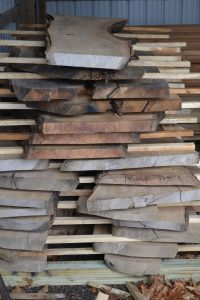Wood is a natural breathing material. Even after a tree is dead and cut down, it absorbs and looses moisture from the atmosphere. This effect is highly based on its environment. Changes in wood moisture result in changes to the dimensions of the material. As moisture is absorbed, the material swells and as moisture is lost, it shrinks. If this process is not properly controlled, boards can crack, warp, twist, and otherwise become less than ideal to work with.
 Lumber comes off of the sawmill in a wet state (typically above 20% moisture content). For most indoor woodworking needs in the midwest, the moisture content needs to be around 8-12% to ensure proper stability before further use in a project. This equilibrium percentage depends on the temperature and humidity in your environment. A simple internet search for wood moisture equilibrium calculator can provide valuable resources to determine when you material is ready to work with.
Lumber comes off of the sawmill in a wet state (typically above 20% moisture content). For most indoor woodworking needs in the midwest, the moisture content needs to be around 8-12% to ensure proper stability before further use in a project. This equilibrium percentage depends on the temperature and humidity in your environment. A simple internet search for wood moisture equilibrium calculator can provide valuable resources to determine when you material is ready to work with.
There are two principle methods for drying lumber. These include kiln drying and air drying. Kiln drying typically involves a large oven of sorts that heats up the material and extracts the moisture in a controlled manner. Not many have access to such kilns and thus the most common method for drying lumber for most hobbyist activities is to air dry the material.
Air drying is simply placing the material in a sheltered environment (such as in a barn or under a lean-to) and allowing the moisture to gradually drop from the material over time. In order to properly dry lumber in this manner, a couple key rules of thumb should be followed:
- Stack the material with small sticks of wood called stickers every 12-18 inches along the length
- Ensure the stack is placed on a level and flat surface to keep the material as flat as possible as it drys
- Stickers should be at least 3/4″ in thickness to allow for proper air circulation around the boards
- Stickers should be as dry as possible to prevent sticker-stain (a process where tannin in the stickers leech into the drying lumber and produce a permanent discoloration that can penetrate deep into the lumber
- A good source of sticker material is standard 3/4″ plywood. Purchase a sheet or two and rip into small 3/4″ or 1″ wide strips. One sheet of plywood can produce a large quantity of stickers for a reasonable price.
- A rule of thumb for drying times when air drying lumber is 1 year per inch of board thickness (i.e. 1 year for 4/4, 2 years for 8/4, etc.)
One important tool any woodworker should have in their toolbox is a moisture meter. There are many different types of meters in a variety of price points. We recommend pin-less meters that use Radio-Frequency energy to measure the moisture content deep within each board. This is the most accurate method to measure board moisture content, but does typically cost substantially more than other types of meters. Pin-type meters that use sharp metal pins shoved into the boards are also a good budget-friendly option to track the moisture content in your material.
Finally, even after following all these tips and guidelines, one may find some boards still tend to warp or twist after drying. Remember that wood is a natural material and can retain built-up stresses or other defects within it, even after drying. By following these tips, however, you will have the best chances of successful drying ensuring excellent lumber for use in your next project.

